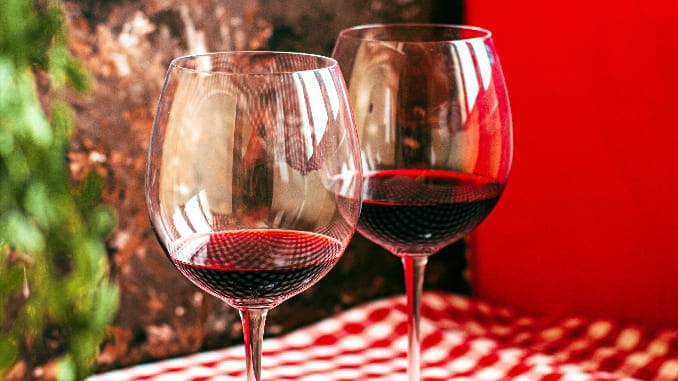
July tastings this year are hot with airy, chillable reds: lighter and sparkling expressions of red varieties. These wines have been a huge hit among tasting participants, and I personally appreciate them as someone who lives in Atlanta where the summer heat is downright disrespectful.
I’m a passionate fan of Gamay, so I’ve always been down for the chillable red. There’s a Beaujolais I had at Kimball House during the optimistic summer of 2021 that I still think about weekly. These kinds of flavor profiles offer light and floral undertones, soft airiness and fruit character without being overwhelmingly saccharine. The wines really pull the drinker into the moment and create an overall super relaxing drinking experience.
Lately, we’ve seen winemakers taking the chillable red to the next level by switching up traditional techniques and adding unexpected effervescence. These imaginative wines expand the conventional boundaries of summertime wine-drinking practices.
Most importantly, we’re seeing experimental blends of creatively chosen varieties from innovative winemakers. Janice Williams, writer for Pix Wines, says, “Any and every red wine grape variety has the potential to become a sparkling wine, which means fizzy reds can be made anywhere on the map.” I’ve had the recent pleasure of tasting some from the west coast.
Summer 2022 has brought many fantastic light reds my way. Earlier this year, I finally met Kelly Cornett, local Atlanta wine hero and podcast host of A Cork in the Road. She held an interactive tasting where we paired wines with different summer experiences, and the hands-down star of the evening was Evening Land’s “Seven Springs” Gamay Noir. This wine is classy, unexpectedly light and bursting with flavor.
I’ve been chasing this dragon all around town, and fortunately for me, chillable reds are everywhere. My go-to wine stop, Kelly’s Market in Decatur, Georgia, continues to deliver with Field Recordings favorites. My gateway into this winery was their dreamy, ice-cold “Freddo.” When it’s chilled to perfection, its label turns blue, signifying that it’s ready to drink.
Many wineries use the classic method of carbonic maceration to develop these exceptional wines. Carbonic maceration involves whole-bunch fermentation, meaning the winemaker is using whole bunches of uncrushed grapes in the fermentation process. This results in a typically earthier flavor profile with sharp, balanced acidity.
This is a method generally practiced with Beaujolais-style wines, as it helps bring out all of the spicy complexity of the Gamay grape. If any of this sounds intriguing, it’s worth noting that many Beaujolais fans also gravitate towards traditional Burgundian styles. These wines are known for malolactic fermentation, the method that adds that buttery or creamy texture to wine.
Lares Wines in Oregon specializes in Burgindian styles. Owner Luke Wylde’s light red blend “Tymora” features a Gamay-Pinot Noir fusion that magically balances tart cherry and smoked tobacco flavors. They also have a skin-contact Aligote, a Burgundian variety similarly known for undergoing malolactic fermentation.
When I first met Wylde over at 3 Parks Wine Shop, he explained how malolactic fermentation helps soften the acidity in wine, allowing winemakers to experiment with complex varieties and a range of flavors without jeopardizing the wine’s balance.
Recently at 3 Parks, the experts advised me to keep Oregon in my sights when searching for trendy, unfiltered reds. Wineries are using the area’s advantageous terroir—deep, well-draining soil with maritime elements—to create dry, fruity, sparkling and unfiltered wines with unique characteristics.
At their suggestion, I immediately fell in love with Fossil and Fawn’s “Do Nothing,” a dry blend of red and white varieties with a salty aroma and a round stone fruit taste. This blend’s fashionably candid name comes from its winemaking process, as explained by winemakers Jim Fischer and Jenny Mosbacher to Minum Selections:
“We fermented wholecluster carbonically—sealing bunches in vats that were left outside for 30 days; experiencing the natural, diurnal fluctuations in temperature. We literally do nothing during this time. The fruit sits and ferments without any input from us. After pressing, 50% of the juice goes into stainless steel tanks and the remaining balance goes into old French oak barrels.”
After five months and no filtration, the result is a wine-drinking experience ideal for July. Its dryness counterbalances humidity in the air, and it expresses a bold fruitiness alternating between ripe berries and salty watermelon.
All of these unique traits and characteristics form the wide spectrum of light reds perfect for this time of year. With such a plethora of options, I often consider unconventional pairings besides food to guide my choices. Dewey, post-rain date nights pair best with soft, floral Beaujolais wines, while smoky summer barbeques demand a spicy Sangiovese. Learning about the winemaking processes and winemaker visions behind my favorite wines inspires me to create thoughtful drinking experiences for myself and celebrate little calm moments within the hectic daze of summer.